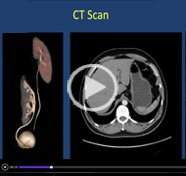Vol. 43 (2): 375-375, March – April, 2017
doi: 10.1590/S1677-5538.IBJU.2016.0042
VIDEO SECTION
Paulo Renato Marcelo Moscardi 1, Roberto Iglesias Lopes 1, Marcos Figueiredo Mello 1, Cristovao Machado Barbosa Neto 1, Bruno Nicolino Cezarino 1, Lorena Marçalo Oliveira 1, Francisco Tibor Dénes 1, Miguel Srougi 1
1 Divisão de Urologia do Departamento de Cirurgia, Universidade de São Paulo, SP, Brasil
ABSTRACT
Introduction: Horseshoe kidney occurs in 1 per 400-800 live births and are more frequently observed in males (M:F 2:1). Ureteropelvic junction obstruction (UPJO) is commonly associated with horseshoe kidneys. The variable blood supply, presence of the isthmus and high insertion of the ureter contribute to this problem.
Case report: An asymptomatic 6 year-old boy presented with antenatal hydronephrosis. Ultrasonography and CT scan demonstrated left UPJO associated with a horseshoe kidney.
DMSA showed 33% of function on the left side. DTPA showed a flat curve and lack of washout. A left dismembered laparoscopic pyeloplasty was performed after identification of crossing vessels and abnormal implantation of the ureter. After one year, the child is asymptomatic. DTPA demonstrated a good washout curve.
Results: Our cohort consisted of six patients, five males and one female, with a mean age of 6 years (range 6m-17 years) and a mean follow-up of 3 years. Ureteropelvic junction obstruction was more common on the left side. Symptoms appeared only in 34% of the cases.
Mean operative time was 198 minutes (range 120-270 minutes). Crossing vessels were common (observed in 50% patients). High implantation of ureter was seen in 67% patients and intrinsic obstruction in 83%. Surgical difficulties were found in two cases. Hospital stay was 4.3 days (3 to 6 days), with only one patient having a mild complication (pyelonephritis). All cases had clinical and radiologic improvement.
Conclusion: Laparoscopic pyeloplasty is safe and feasible in children with UPJO in horseshoe kidneys, with good results and minimal morbidity.


